Leadership and Culture: Styles, Theories, and Examples - Essay
VerifiedAdded on 2023/01/11
|16
|4498
|3
Essay
AI Summary
This essay delves into the multifaceted concept of leadership, defining it as a process of influencing and directing individuals towards organizational objectives. It emphasizes the distinction between leadership and management, highlighting the leader's role in motivating employees, fostering a positive work environment, and adapting to change. The essay explores various leadership styles, including authoritarian, participative, laissez-faire, transformational, transactional, charismatic, and distributive leadership, examining their characteristics, ethical implications, and relevance to different organizational contexts. It also addresses the challenges of cross-cultural leadership and the importance of understanding diverse values and beliefs. Furthermore, the essay discusses the role of leaders in implementing talent management strategies, focusing on human capital management, recruitment, training, and fostering employee growth. The essay provides a comprehensive overview of leadership theories and their practical applications, offering insights into effective leadership practices and their impact on organizational success.
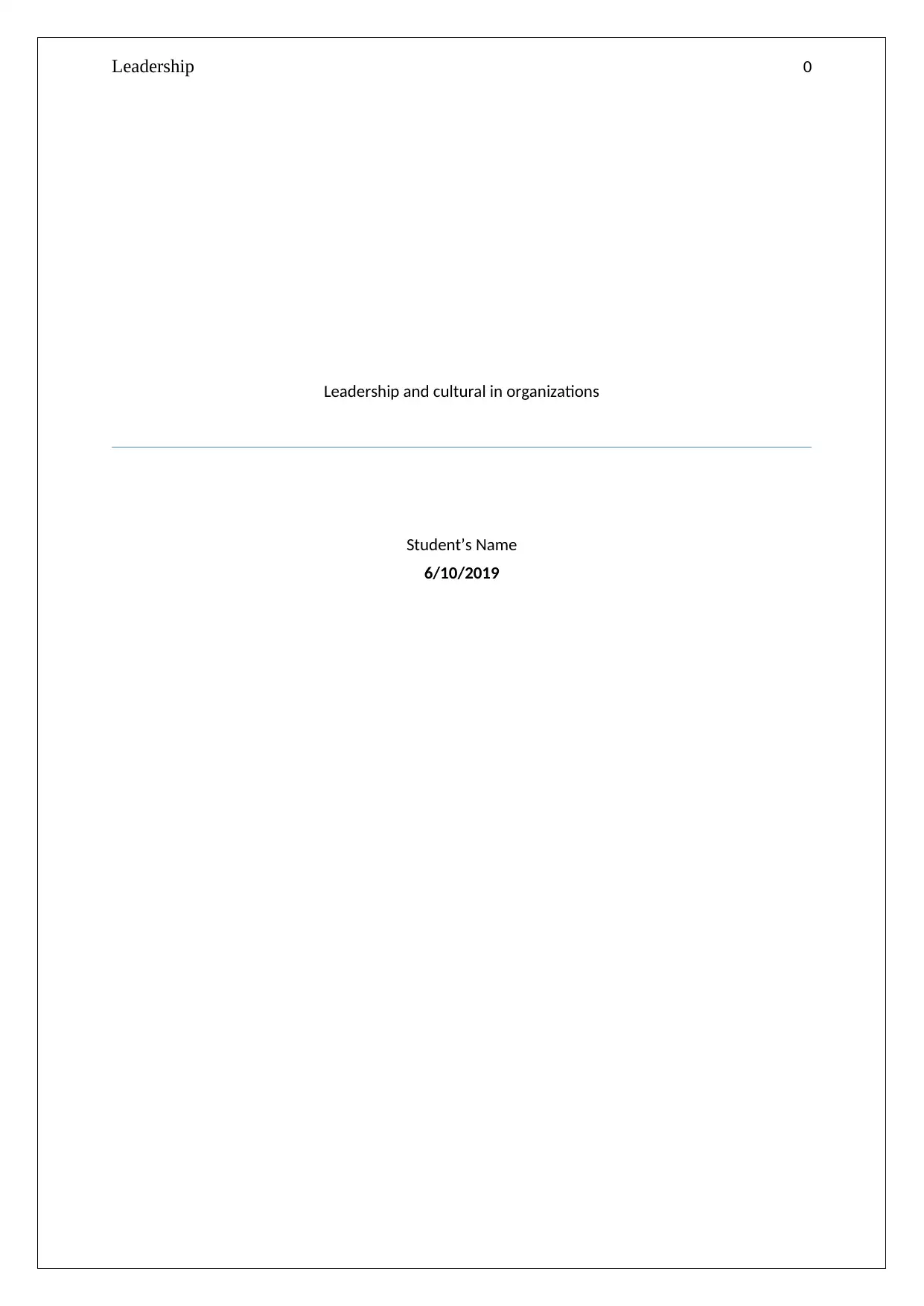
Leadership 0
Leadership and cultural in organizations
Student’s Name
6/10/2019
Leadership and cultural in organizations
Student’s Name
6/10/2019
Paraphrase This Document
Need a fresh take? Get an instant paraphrase of this document with our AI Paraphraser
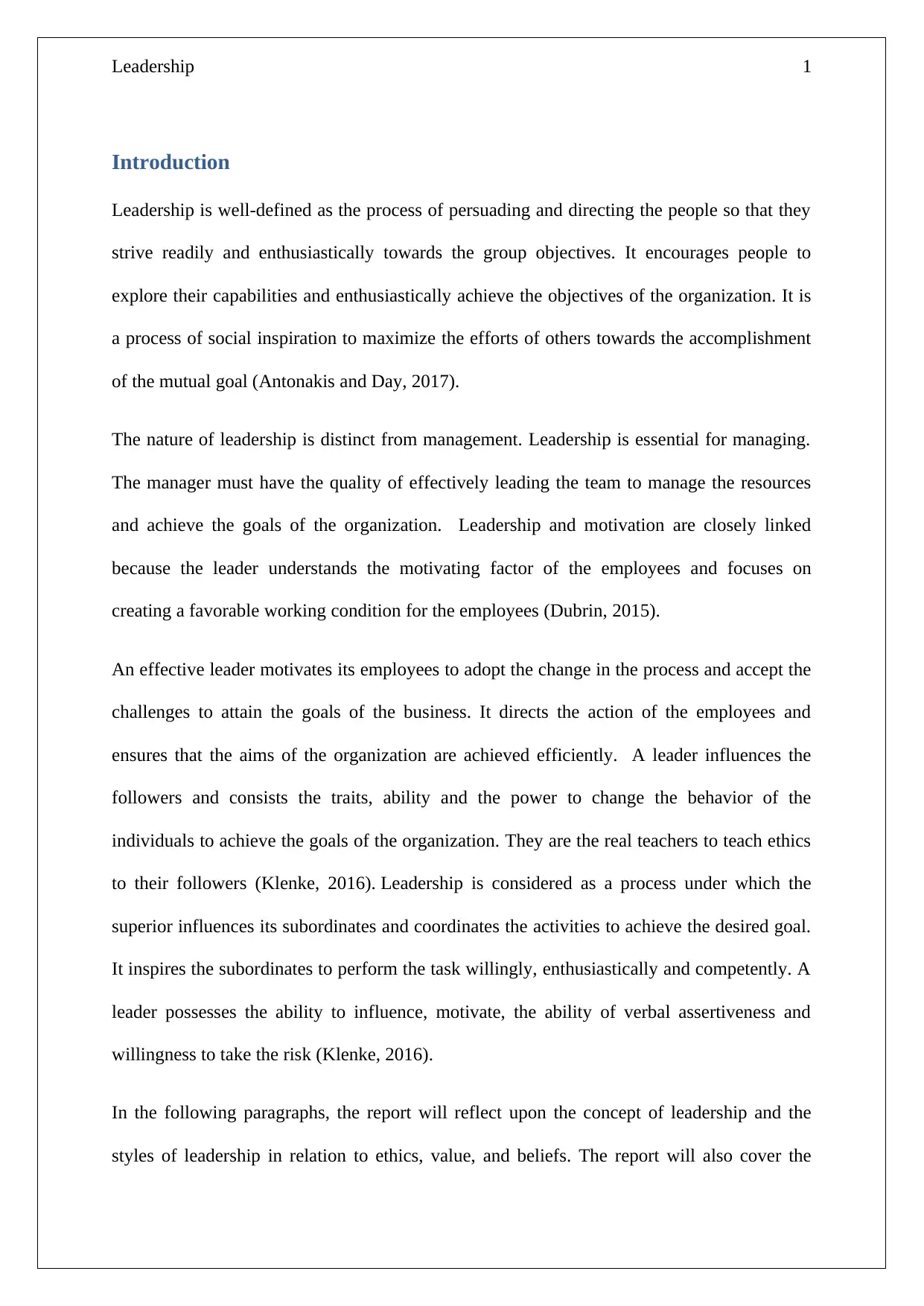
Leadership 1
Introduction
Leadership is well-defined as the process of persuading and directing the people so that they
strive readily and enthusiastically towards the group objectives. It encourages people to
explore their capabilities and enthusiastically achieve the objectives of the organization. It is
a process of social inspiration to maximize the efforts of others towards the accomplishment
of the mutual goal (Antonakis and Day, 2017).
The nature of leadership is distinct from management. Leadership is essential for managing.
The manager must have the quality of effectively leading the team to manage the resources
and achieve the goals of the organization. Leadership and motivation are closely linked
because the leader understands the motivating factor of the employees and focuses on
creating a favorable working condition for the employees (Dubrin, 2015).
An effective leader motivates its employees to adopt the change in the process and accept the
challenges to attain the goals of the business. It directs the action of the employees and
ensures that the aims of the organization are achieved efficiently. A leader influences the
followers and consists the traits, ability and the power to change the behavior of the
individuals to achieve the goals of the organization. They are the real teachers to teach ethics
to their followers (Klenke, 2016). Leadership is considered as a process under which the
superior influences its subordinates and coordinates the activities to achieve the desired goal.
It inspires the subordinates to perform the task willingly, enthusiastically and competently. A
leader possesses the ability to influence, motivate, the ability of verbal assertiveness and
willingness to take the risk (Klenke, 2016).
In the following paragraphs, the report will reflect upon the concept of leadership and the
styles of leadership in relation to ethics, value, and beliefs. The report will also cover the
Introduction
Leadership is well-defined as the process of persuading and directing the people so that they
strive readily and enthusiastically towards the group objectives. It encourages people to
explore their capabilities and enthusiastically achieve the objectives of the organization. It is
a process of social inspiration to maximize the efforts of others towards the accomplishment
of the mutual goal (Antonakis and Day, 2017).
The nature of leadership is distinct from management. Leadership is essential for managing.
The manager must have the quality of effectively leading the team to manage the resources
and achieve the goals of the organization. Leadership and motivation are closely linked
because the leader understands the motivating factor of the employees and focuses on
creating a favorable working condition for the employees (Dubrin, 2015).
An effective leader motivates its employees to adopt the change in the process and accept the
challenges to attain the goals of the business. It directs the action of the employees and
ensures that the aims of the organization are achieved efficiently. A leader influences the
followers and consists the traits, ability and the power to change the behavior of the
individuals to achieve the goals of the organization. They are the real teachers to teach ethics
to their followers (Klenke, 2016). Leadership is considered as a process under which the
superior influences its subordinates and coordinates the activities to achieve the desired goal.
It inspires the subordinates to perform the task willingly, enthusiastically and competently. A
leader possesses the ability to influence, motivate, the ability of verbal assertiveness and
willingness to take the risk (Klenke, 2016).
In the following paragraphs, the report will reflect upon the concept of leadership and the
styles of leadership in relation to ethics, value, and beliefs. The report will also cover the
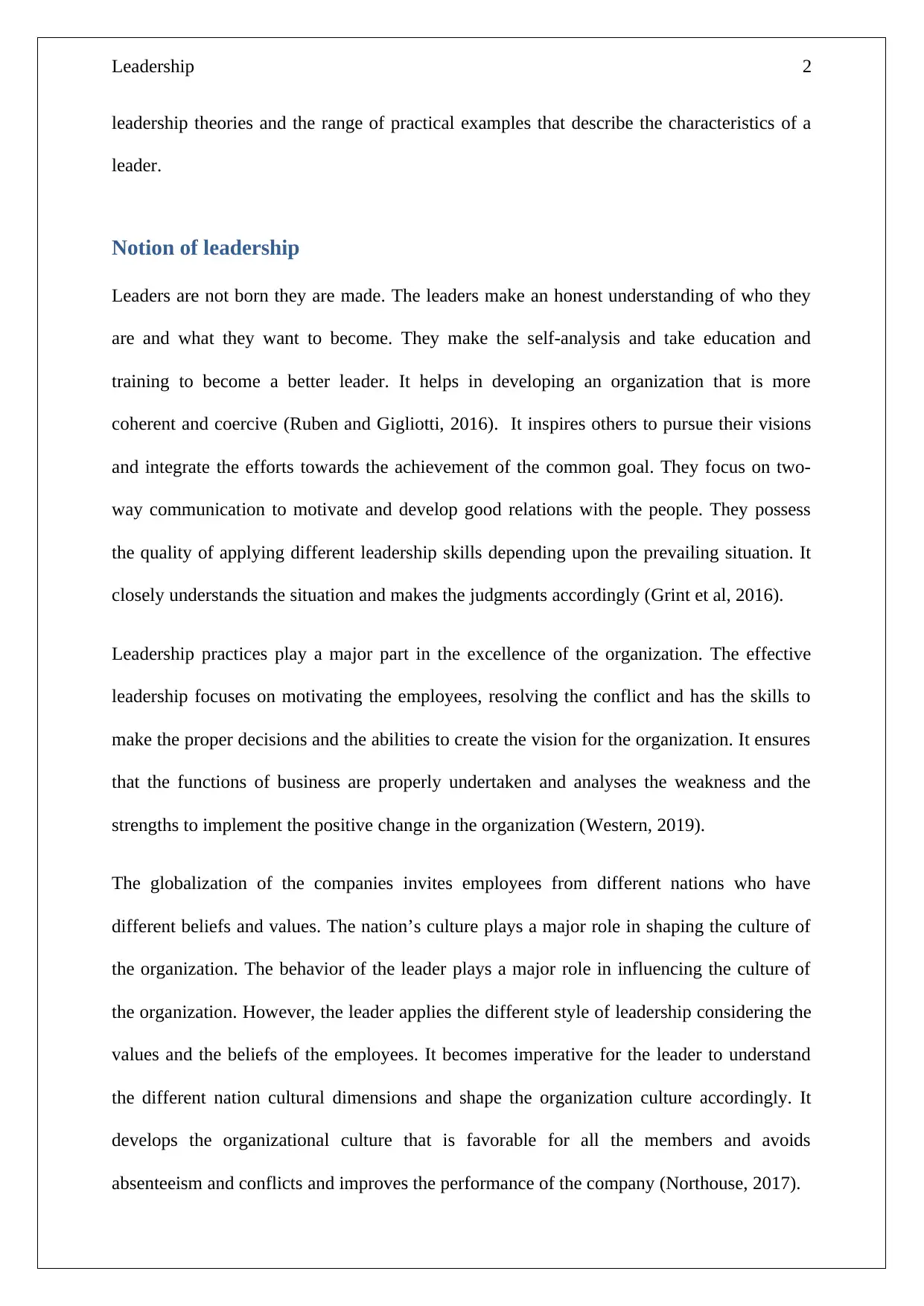
Leadership 2
leadership theories and the range of practical examples that describe the characteristics of a
leader.
Notion of leadership
Leaders are not born they are made. The leaders make an honest understanding of who they
are and what they want to become. They make the self-analysis and take education and
training to become a better leader. It helps in developing an organization that is more
coherent and coercive (Ruben and Gigliotti, 2016). It inspires others to pursue their visions
and integrate the efforts towards the achievement of the common goal. They focus on two-
way communication to motivate and develop good relations with the people. They possess
the quality of applying different leadership skills depending upon the prevailing situation. It
closely understands the situation and makes the judgments accordingly (Grint et al, 2016).
Leadership practices play a major part in the excellence of the organization. The effective
leadership focuses on motivating the employees, resolving the conflict and has the skills to
make the proper decisions and the abilities to create the vision for the organization. It ensures
that the functions of business are properly undertaken and analyses the weakness and the
strengths to implement the positive change in the organization (Western, 2019).
The globalization of the companies invites employees from different nations who have
different beliefs and values. The nation’s culture plays a major role in shaping the culture of
the organization. The behavior of the leader plays a major role in influencing the culture of
the organization. However, the leader applies the different style of leadership considering the
values and the beliefs of the employees. It becomes imperative for the leader to understand
the different nation cultural dimensions and shape the organization culture accordingly. It
develops the organizational culture that is favorable for all the members and avoids
absenteeism and conflicts and improves the performance of the company (Northouse, 2017).
leadership theories and the range of practical examples that describe the characteristics of a
leader.
Notion of leadership
Leaders are not born they are made. The leaders make an honest understanding of who they
are and what they want to become. They make the self-analysis and take education and
training to become a better leader. It helps in developing an organization that is more
coherent and coercive (Ruben and Gigliotti, 2016). It inspires others to pursue their visions
and integrate the efforts towards the achievement of the common goal. They focus on two-
way communication to motivate and develop good relations with the people. They possess
the quality of applying different leadership skills depending upon the prevailing situation. It
closely understands the situation and makes the judgments accordingly (Grint et al, 2016).
Leadership practices play a major part in the excellence of the organization. The effective
leadership focuses on motivating the employees, resolving the conflict and has the skills to
make the proper decisions and the abilities to create the vision for the organization. It ensures
that the functions of business are properly undertaken and analyses the weakness and the
strengths to implement the positive change in the organization (Western, 2019).
The globalization of the companies invites employees from different nations who have
different beliefs and values. The nation’s culture plays a major role in shaping the culture of
the organization. The behavior of the leader plays a major role in influencing the culture of
the organization. However, the leader applies the different style of leadership considering the
values and the beliefs of the employees. It becomes imperative for the leader to understand
the different nation cultural dimensions and shape the organization culture accordingly. It
develops the organizational culture that is favorable for all the members and avoids
absenteeism and conflicts and improves the performance of the company (Northouse, 2017).
⊘ This is a preview!⊘
Do you want full access?
Subscribe today to unlock all pages.

Trusted by 1+ million students worldwide
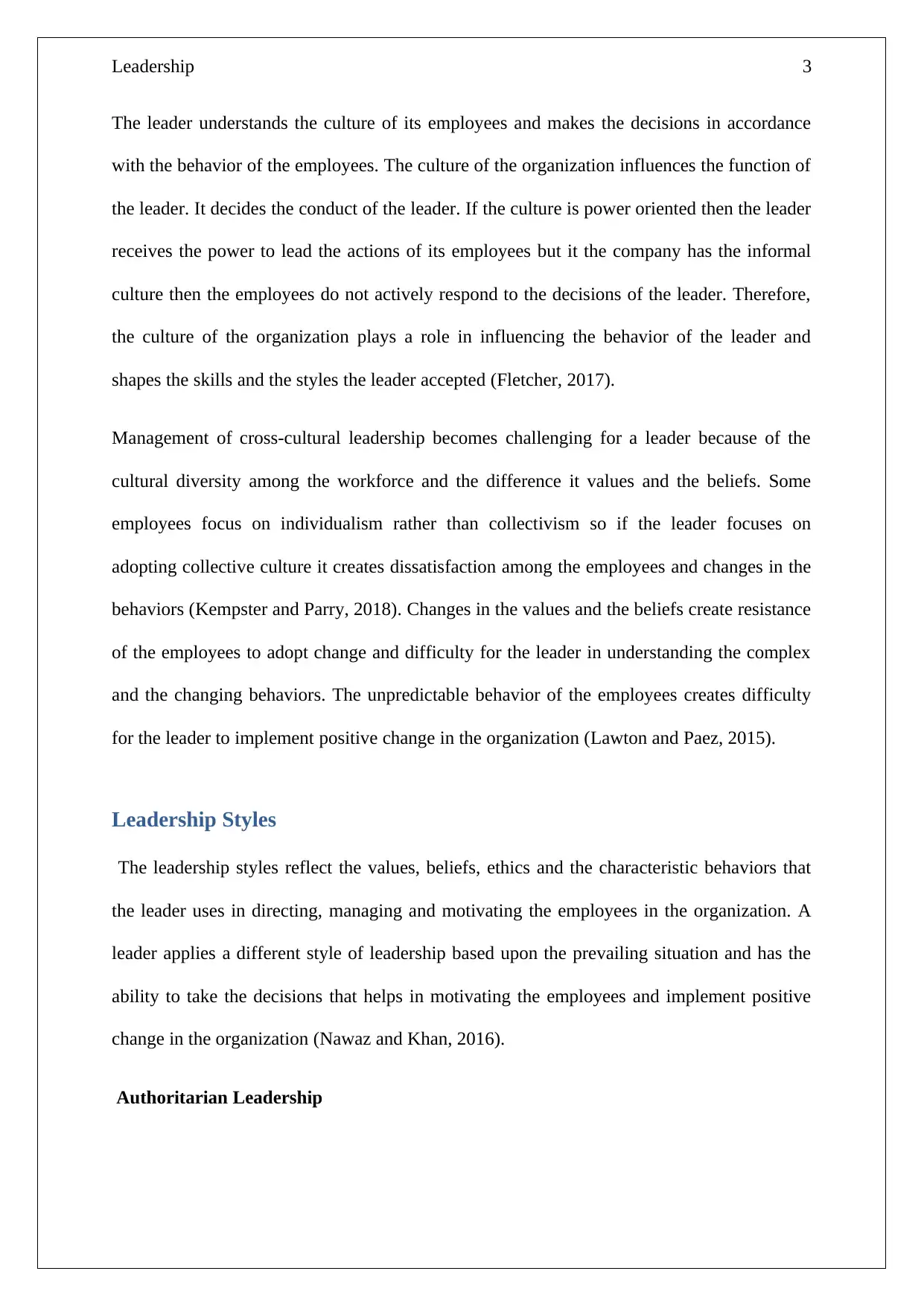
Leadership 3
The leader understands the culture of its employees and makes the decisions in accordance
with the behavior of the employees. The culture of the organization influences the function of
the leader. It decides the conduct of the leader. If the culture is power oriented then the leader
receives the power to lead the actions of its employees but it the company has the informal
culture then the employees do not actively respond to the decisions of the leader. Therefore,
the culture of the organization plays a role in influencing the behavior of the leader and
shapes the skills and the styles the leader accepted (Fletcher, 2017).
Management of cross-cultural leadership becomes challenging for a leader because of the
cultural diversity among the workforce and the difference it values and the beliefs. Some
employees focus on individualism rather than collectivism so if the leader focuses on
adopting collective culture it creates dissatisfaction among the employees and changes in the
behaviors (Kempster and Parry, 2018). Changes in the values and the beliefs create resistance
of the employees to adopt change and difficulty for the leader in understanding the complex
and the changing behaviors. The unpredictable behavior of the employees creates difficulty
for the leader to implement positive change in the organization (Lawton and Paez, 2015).
Leadership Styles
The leadership styles reflect the values, beliefs, ethics and the characteristic behaviors that
the leader uses in directing, managing and motivating the employees in the organization. A
leader applies a different style of leadership based upon the prevailing situation and has the
ability to take the decisions that helps in motivating the employees and implement positive
change in the organization (Nawaz and Khan, 2016).
Authoritarian Leadership
The leader understands the culture of its employees and makes the decisions in accordance
with the behavior of the employees. The culture of the organization influences the function of
the leader. It decides the conduct of the leader. If the culture is power oriented then the leader
receives the power to lead the actions of its employees but it the company has the informal
culture then the employees do not actively respond to the decisions of the leader. Therefore,
the culture of the organization plays a role in influencing the behavior of the leader and
shapes the skills and the styles the leader accepted (Fletcher, 2017).
Management of cross-cultural leadership becomes challenging for a leader because of the
cultural diversity among the workforce and the difference it values and the beliefs. Some
employees focus on individualism rather than collectivism so if the leader focuses on
adopting collective culture it creates dissatisfaction among the employees and changes in the
behaviors (Kempster and Parry, 2018). Changes in the values and the beliefs create resistance
of the employees to adopt change and difficulty for the leader in understanding the complex
and the changing behaviors. The unpredictable behavior of the employees creates difficulty
for the leader to implement positive change in the organization (Lawton and Paez, 2015).
Leadership Styles
The leadership styles reflect the values, beliefs, ethics and the characteristic behaviors that
the leader uses in directing, managing and motivating the employees in the organization. A
leader applies a different style of leadership based upon the prevailing situation and has the
ability to take the decisions that helps in motivating the employees and implement positive
change in the organization (Nawaz and Khan, 2016).
Authoritarian Leadership
Paraphrase This Document
Need a fresh take? Get an instant paraphrase of this document with our AI Paraphraser
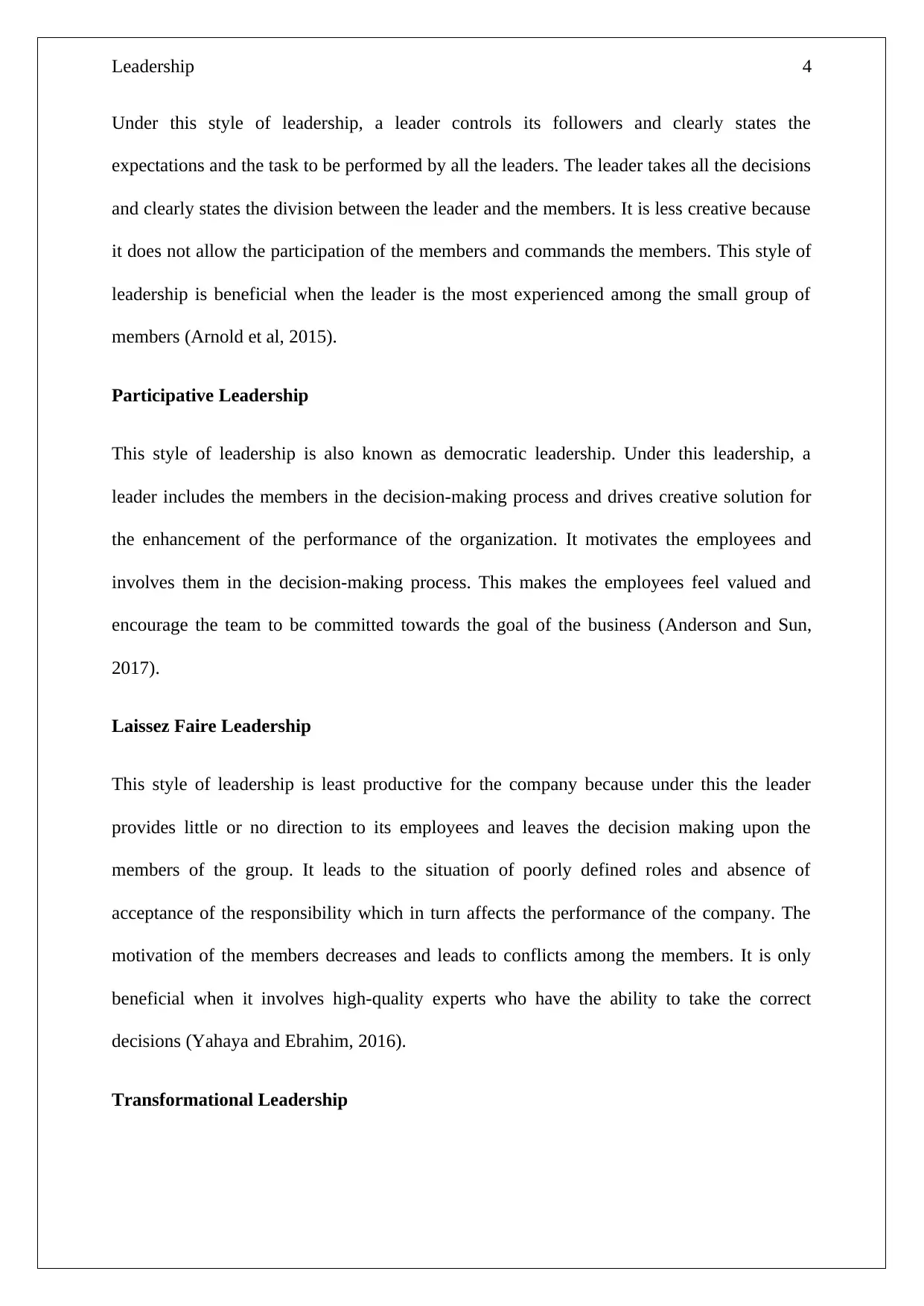
Leadership 4
Under this style of leadership, a leader controls its followers and clearly states the
expectations and the task to be performed by all the leaders. The leader takes all the decisions
and clearly states the division between the leader and the members. It is less creative because
it does not allow the participation of the members and commands the members. This style of
leadership is beneficial when the leader is the most experienced among the small group of
members (Arnold et al, 2015).
Participative Leadership
This style of leadership is also known as democratic leadership. Under this leadership, a
leader includes the members in the decision-making process and drives creative solution for
the enhancement of the performance of the organization. It motivates the employees and
involves them in the decision-making process. This makes the employees feel valued and
encourage the team to be committed towards the goal of the business (Anderson and Sun,
2017).
Laissez Faire Leadership
This style of leadership is least productive for the company because under this the leader
provides little or no direction to its employees and leaves the decision making upon the
members of the group. It leads to the situation of poorly defined roles and absence of
acceptance of the responsibility which in turn affects the performance of the company. The
motivation of the members decreases and leads to conflicts among the members. It is only
beneficial when it involves high-quality experts who have the ability to take the correct
decisions (Yahaya and Ebrahim, 2016).
Transformational Leadership
Under this style of leadership, a leader controls its followers and clearly states the
expectations and the task to be performed by all the leaders. The leader takes all the decisions
and clearly states the division between the leader and the members. It is less creative because
it does not allow the participation of the members and commands the members. This style of
leadership is beneficial when the leader is the most experienced among the small group of
members (Arnold et al, 2015).
Participative Leadership
This style of leadership is also known as democratic leadership. Under this leadership, a
leader includes the members in the decision-making process and drives creative solution for
the enhancement of the performance of the organization. It motivates the employees and
involves them in the decision-making process. This makes the employees feel valued and
encourage the team to be committed towards the goal of the business (Anderson and Sun,
2017).
Laissez Faire Leadership
This style of leadership is least productive for the company because under this the leader
provides little or no direction to its employees and leaves the decision making upon the
members of the group. It leads to the situation of poorly defined roles and absence of
acceptance of the responsibility which in turn affects the performance of the company. The
motivation of the members decreases and leads to conflicts among the members. It is only
beneficial when it involves high-quality experts who have the ability to take the correct
decisions (Yahaya and Ebrahim, 2016).
Transformational Leadership
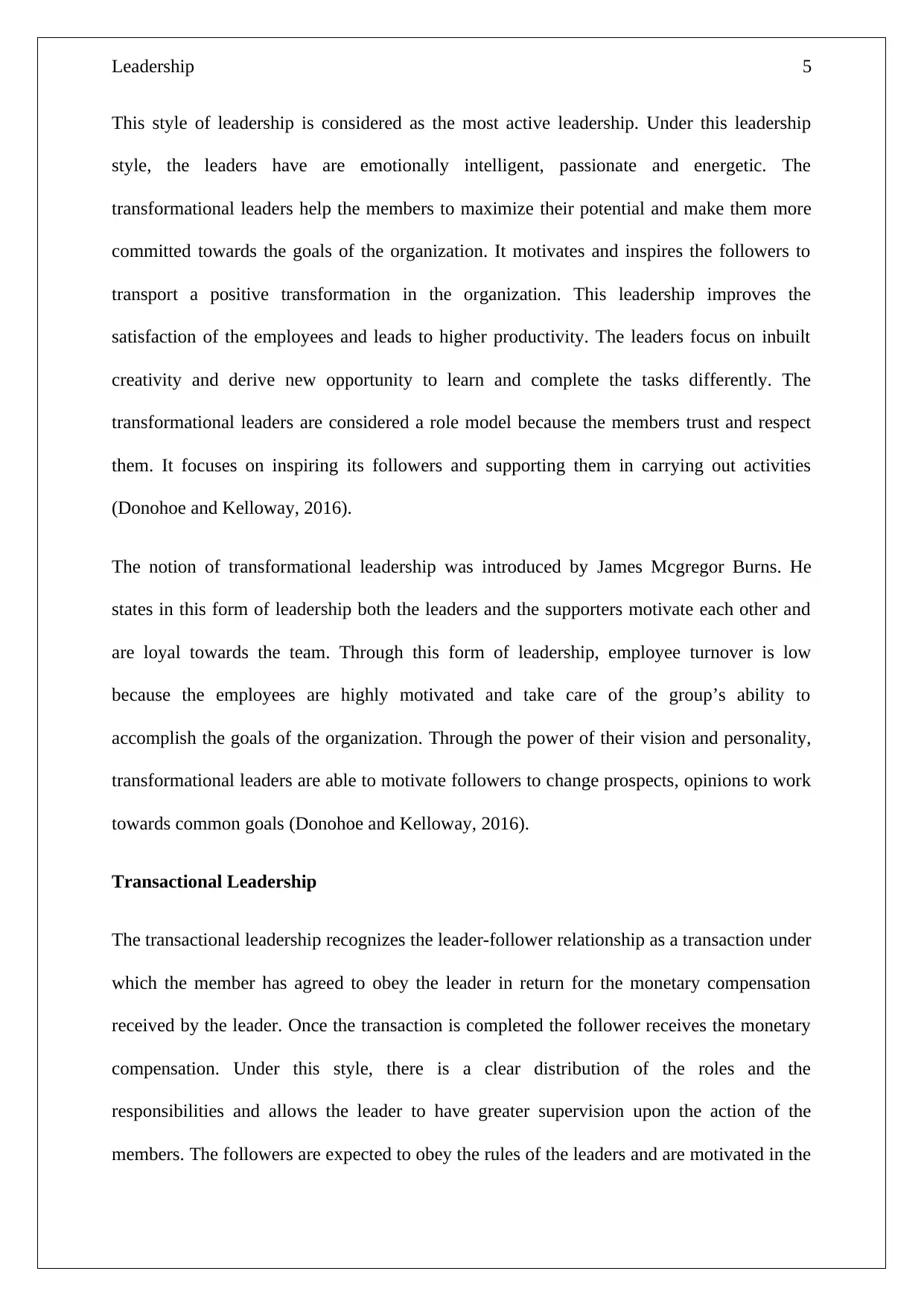
Leadership 5
This style of leadership is considered as the most active leadership. Under this leadership
style, the leaders have are emotionally intelligent, passionate and energetic. The
transformational leaders help the members to maximize their potential and make them more
committed towards the goals of the organization. It motivates and inspires the followers to
transport a positive transformation in the organization. This leadership improves the
satisfaction of the employees and leads to higher productivity. The leaders focus on inbuilt
creativity and derive new opportunity to learn and complete the tasks differently. The
transformational leaders are considered a role model because the members trust and respect
them. It focuses on inspiring its followers and supporting them in carrying out activities
(Donohoe and Kelloway, 2016).
The notion of transformational leadership was introduced by James Mcgregor Burns. He
states in this form of leadership both the leaders and the supporters motivate each other and
are loyal towards the team. Through this form of leadership, employee turnover is low
because the employees are highly motivated and take care of the group’s ability to
accomplish the goals of the organization. Through the power of their vision and personality,
transformational leaders are able to motivate followers to change prospects, opinions to work
towards common goals (Donohoe and Kelloway, 2016).
Transactional Leadership
The transactional leadership recognizes the leader-follower relationship as a transaction under
which the member has agreed to obey the leader in return for the monetary compensation
received by the leader. Once the transaction is completed the follower receives the monetary
compensation. Under this style, there is a clear distribution of the roles and the
responsibilities and allows the leader to have greater supervision upon the action of the
members. The followers are expected to obey the rules of the leaders and are motivated in the
This style of leadership is considered as the most active leadership. Under this leadership
style, the leaders have are emotionally intelligent, passionate and energetic. The
transformational leaders help the members to maximize their potential and make them more
committed towards the goals of the organization. It motivates and inspires the followers to
transport a positive transformation in the organization. This leadership improves the
satisfaction of the employees and leads to higher productivity. The leaders focus on inbuilt
creativity and derive new opportunity to learn and complete the tasks differently. The
transformational leaders are considered a role model because the members trust and respect
them. It focuses on inspiring its followers and supporting them in carrying out activities
(Donohoe and Kelloway, 2016).
The notion of transformational leadership was introduced by James Mcgregor Burns. He
states in this form of leadership both the leaders and the supporters motivate each other and
are loyal towards the team. Through this form of leadership, employee turnover is low
because the employees are highly motivated and take care of the group’s ability to
accomplish the goals of the organization. Through the power of their vision and personality,
transformational leaders are able to motivate followers to change prospects, opinions to work
towards common goals (Donohoe and Kelloway, 2016).
Transactional Leadership
The transactional leadership recognizes the leader-follower relationship as a transaction under
which the member has agreed to obey the leader in return for the monetary compensation
received by the leader. Once the transaction is completed the follower receives the monetary
compensation. Under this style, there is a clear distribution of the roles and the
responsibilities and allows the leader to have greater supervision upon the action of the
members. The followers are expected to obey the rules of the leaders and are motivated in the
⊘ This is a preview!⊘
Do you want full access?
Subscribe today to unlock all pages.

Trusted by 1+ million students worldwide
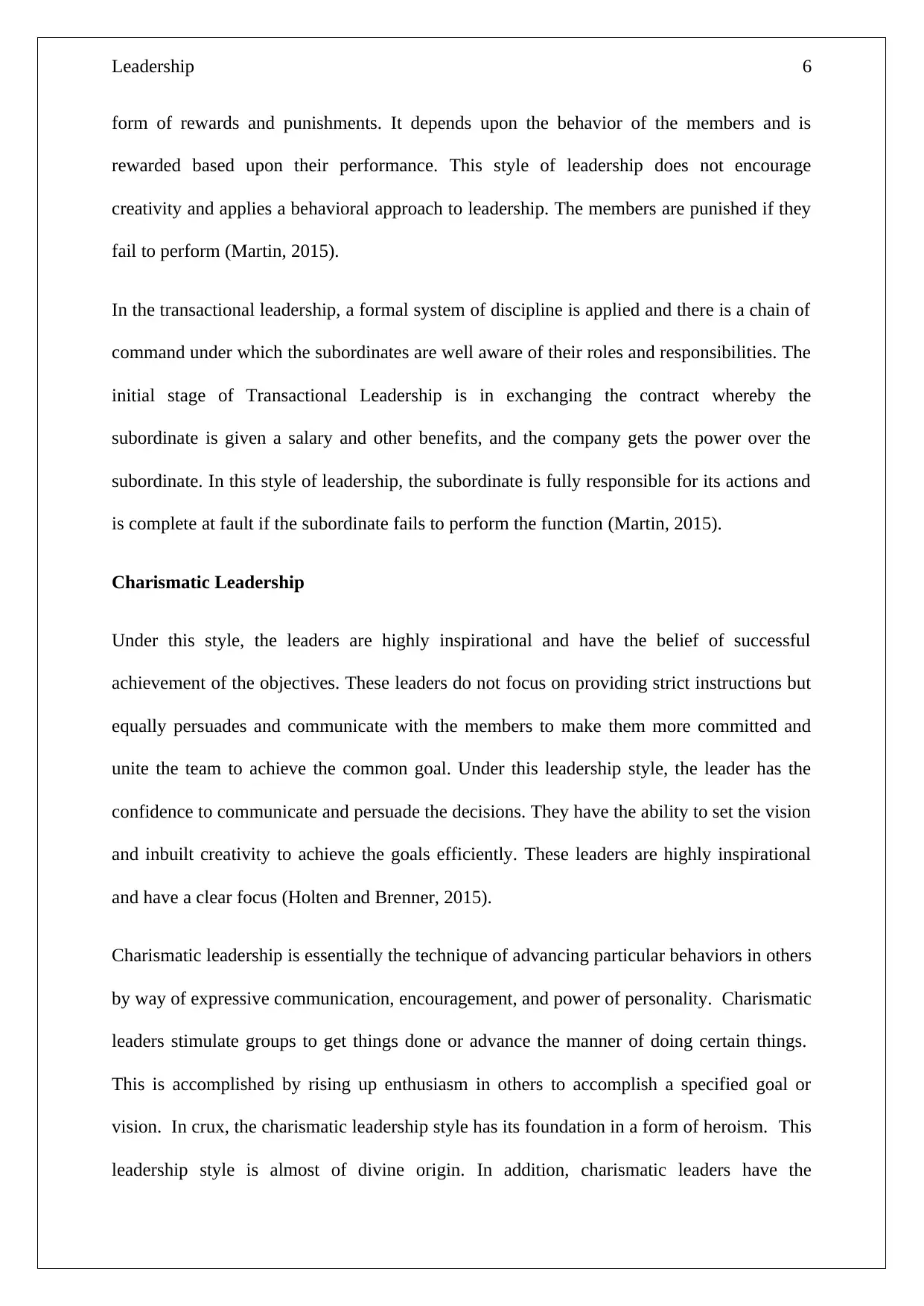
Leadership 6
form of rewards and punishments. It depends upon the behavior of the members and is
rewarded based upon their performance. This style of leadership does not encourage
creativity and applies a behavioral approach to leadership. The members are punished if they
fail to perform (Martin, 2015).
In the transactional leadership, a formal system of discipline is applied and there is a chain of
command under which the subordinates are well aware of their roles and responsibilities. The
initial stage of Transactional Leadership is in exchanging the contract whereby the
subordinate is given a salary and other benefits, and the company gets the power over the
subordinate. In this style of leadership, the subordinate is fully responsible for its actions and
is complete at fault if the subordinate fails to perform the function (Martin, 2015).
Charismatic Leadership
Under this style, the leaders are highly inspirational and have the belief of successful
achievement of the objectives. These leaders do not focus on providing strict instructions but
equally persuades and communicate with the members to make them more committed and
unite the team to achieve the common goal. Under this leadership style, the leader has the
confidence to communicate and persuade the decisions. They have the ability to set the vision
and inbuilt creativity to achieve the goals efficiently. These leaders are highly inspirational
and have a clear focus (Holten and Brenner, 2015).
Charismatic leadership is essentially the technique of advancing particular behaviors in others
by way of expressive communication, encouragement, and power of personality. Charismatic
leaders stimulate groups to get things done or advance the manner of doing certain things.
This is accomplished by rising up enthusiasm in others to accomplish a specified goal or
vision. In crux, the charismatic leadership style has its foundation in a form of heroism. This
leadership style is almost of divine origin. In addition, charismatic leaders have the
form of rewards and punishments. It depends upon the behavior of the members and is
rewarded based upon their performance. This style of leadership does not encourage
creativity and applies a behavioral approach to leadership. The members are punished if they
fail to perform (Martin, 2015).
In the transactional leadership, a formal system of discipline is applied and there is a chain of
command under which the subordinates are well aware of their roles and responsibilities. The
initial stage of Transactional Leadership is in exchanging the contract whereby the
subordinate is given a salary and other benefits, and the company gets the power over the
subordinate. In this style of leadership, the subordinate is fully responsible for its actions and
is complete at fault if the subordinate fails to perform the function (Martin, 2015).
Charismatic Leadership
Under this style, the leaders are highly inspirational and have the belief of successful
achievement of the objectives. These leaders do not focus on providing strict instructions but
equally persuades and communicate with the members to make them more committed and
unite the team to achieve the common goal. Under this leadership style, the leader has the
confidence to communicate and persuade the decisions. They have the ability to set the vision
and inbuilt creativity to achieve the goals efficiently. These leaders are highly inspirational
and have a clear focus (Holten and Brenner, 2015).
Charismatic leadership is essentially the technique of advancing particular behaviors in others
by way of expressive communication, encouragement, and power of personality. Charismatic
leaders stimulate groups to get things done or advance the manner of doing certain things.
This is accomplished by rising up enthusiasm in others to accomplish a specified goal or
vision. In crux, the charismatic leadership style has its foundation in a form of heroism. This
leadership style is almost of divine origin. In addition, charismatic leaders have the
Paraphrase This Document
Need a fresh take? Get an instant paraphrase of this document with our AI Paraphraser
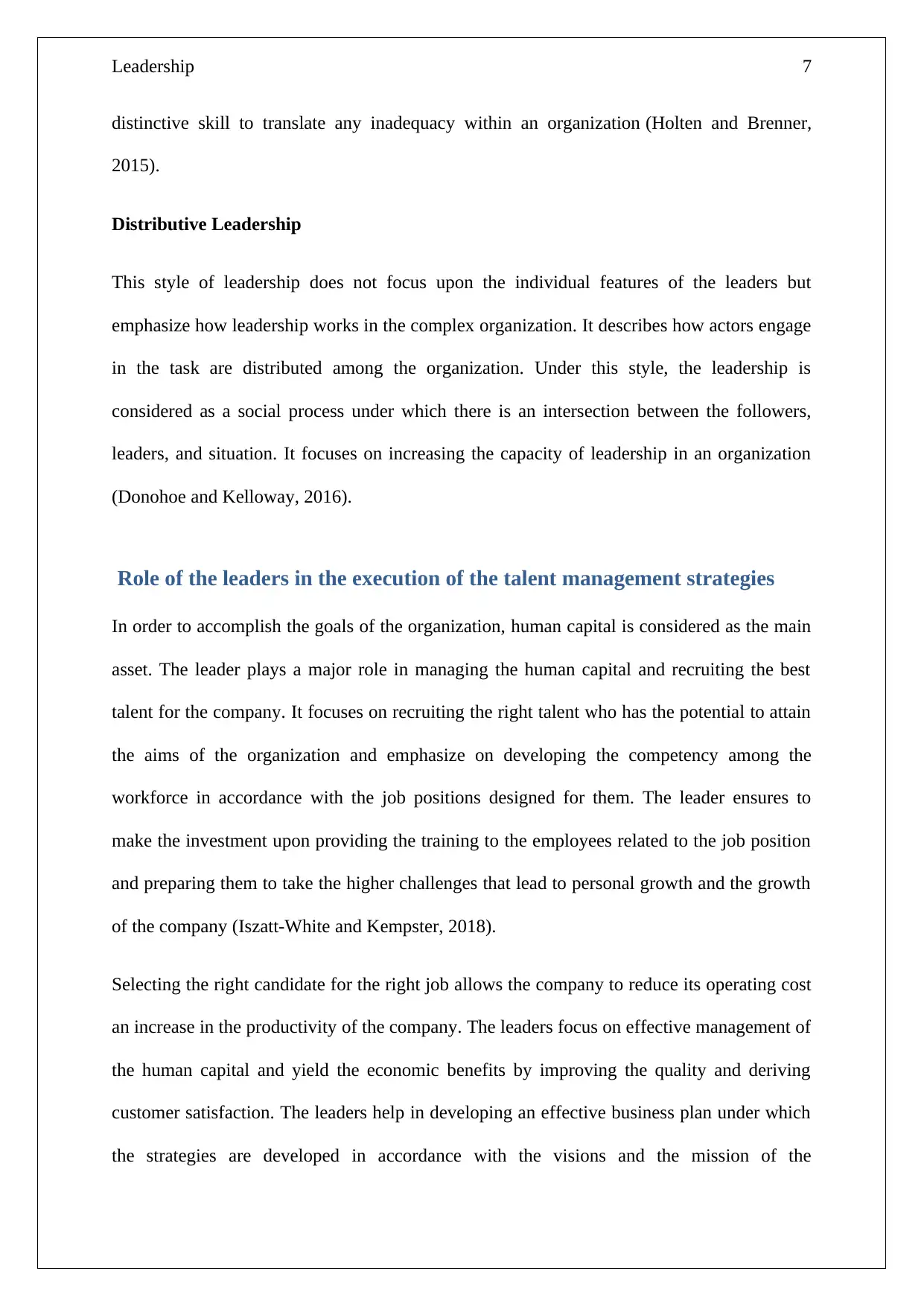
Leadership 7
distinctive skill to translate any inadequacy within an organization (Holten and Brenner,
2015).
Distributive Leadership
This style of leadership does not focus upon the individual features of the leaders but
emphasize how leadership works in the complex organization. It describes how actors engage
in the task are distributed among the organization. Under this style, the leadership is
considered as a social process under which there is an intersection between the followers,
leaders, and situation. It focuses on increasing the capacity of leadership in an organization
(Donohoe and Kelloway, 2016).
Role of the leaders in the execution of the talent management strategies
In order to accomplish the goals of the organization, human capital is considered as the main
asset. The leader plays a major role in managing the human capital and recruiting the best
talent for the company. It focuses on recruiting the right talent who has the potential to attain
the aims of the organization and emphasize on developing the competency among the
workforce in accordance with the job positions designed for them. The leader ensures to
make the investment upon providing the training to the employees related to the job position
and preparing them to take the higher challenges that lead to personal growth and the growth
of the company (Iszatt‐White and Kempster, 2018).
Selecting the right candidate for the right job allows the company to reduce its operating cost
an increase in the productivity of the company. The leaders focus on effective management of
the human capital and yield the economic benefits by improving the quality and deriving
customer satisfaction. The leaders help in developing an effective business plan under which
the strategies are developed in accordance with the visions and the mission of the
distinctive skill to translate any inadequacy within an organization (Holten and Brenner,
2015).
Distributive Leadership
This style of leadership does not focus upon the individual features of the leaders but
emphasize how leadership works in the complex organization. It describes how actors engage
in the task are distributed among the organization. Under this style, the leadership is
considered as a social process under which there is an intersection between the followers,
leaders, and situation. It focuses on increasing the capacity of leadership in an organization
(Donohoe and Kelloway, 2016).
Role of the leaders in the execution of the talent management strategies
In order to accomplish the goals of the organization, human capital is considered as the main
asset. The leader plays a major role in managing the human capital and recruiting the best
talent for the company. It focuses on recruiting the right talent who has the potential to attain
the aims of the organization and emphasize on developing the competency among the
workforce in accordance with the job positions designed for them. The leader ensures to
make the investment upon providing the training to the employees related to the job position
and preparing them to take the higher challenges that lead to personal growth and the growth
of the company (Iszatt‐White and Kempster, 2018).
Selecting the right candidate for the right job allows the company to reduce its operating cost
an increase in the productivity of the company. The leaders focus on effective management of
the human capital and yield the economic benefits by improving the quality and deriving
customer satisfaction. The leaders help in developing an effective business plan under which
the strategies are developed in accordance with the visions and the mission of the
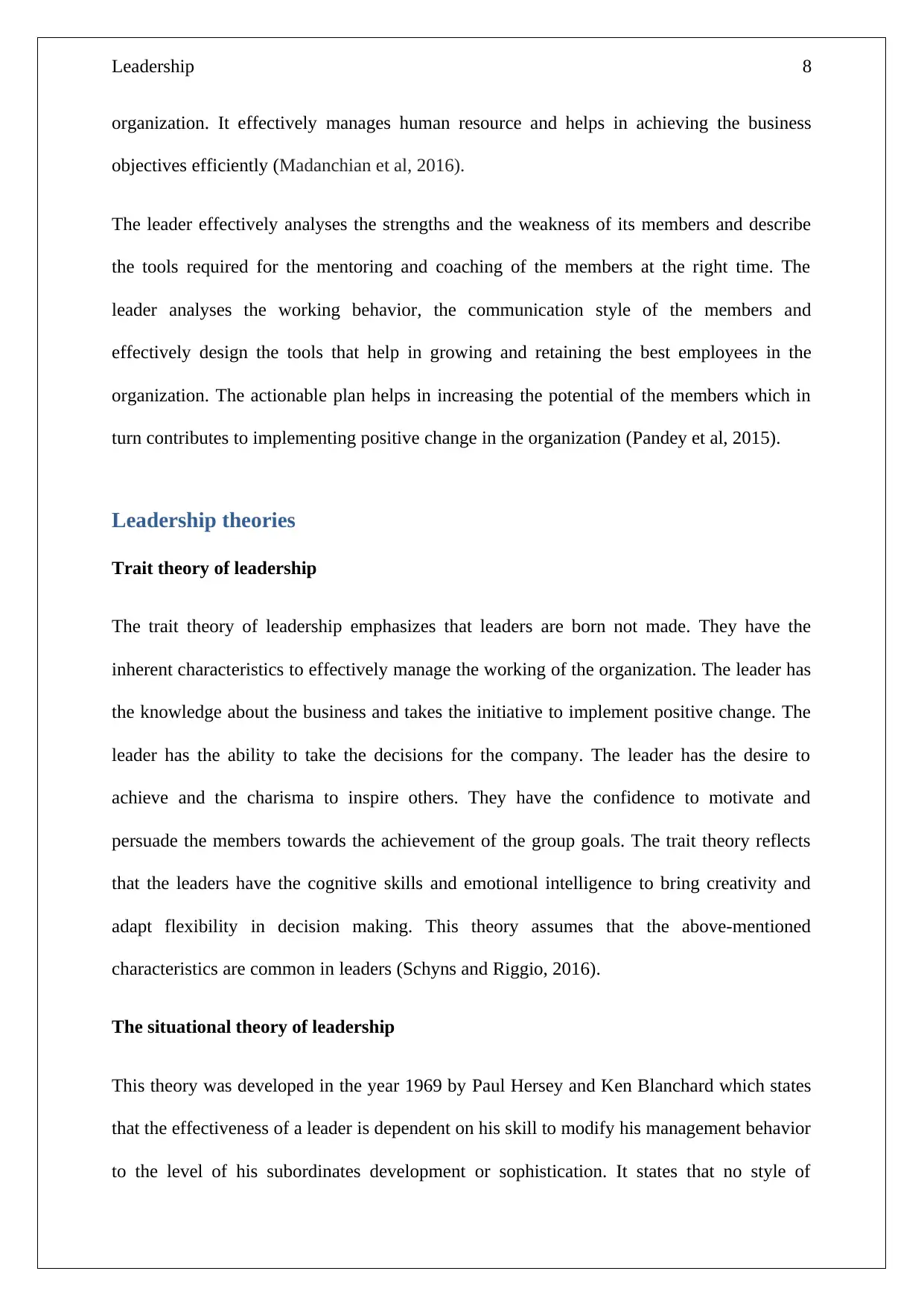
Leadership 8
organization. It effectively manages human resource and helps in achieving the business
objectives efficiently (Madanchian et al, 2016).
The leader effectively analyses the strengths and the weakness of its members and describe
the tools required for the mentoring and coaching of the members at the right time. The
leader analyses the working behavior, the communication style of the members and
effectively design the tools that help in growing and retaining the best employees in the
organization. The actionable plan helps in increasing the potential of the members which in
turn contributes to implementing positive change in the organization (Pandey et al, 2015).
Leadership theories
Trait theory of leadership
The trait theory of leadership emphasizes that leaders are born not made. They have the
inherent characteristics to effectively manage the working of the organization. The leader has
the knowledge about the business and takes the initiative to implement positive change. The
leader has the ability to take the decisions for the company. The leader has the desire to
achieve and the charisma to inspire others. They have the confidence to motivate and
persuade the members towards the achievement of the group goals. The trait theory reflects
that the leaders have the cognitive skills and emotional intelligence to bring creativity and
adapt flexibility in decision making. This theory assumes that the above-mentioned
characteristics are common in leaders (Schyns and Riggio, 2016).
The situational theory of leadership
This theory was developed in the year 1969 by Paul Hersey and Ken Blanchard which states
that the effectiveness of a leader is dependent on his skill to modify his management behavior
to the level of his subordinates development or sophistication. It states that no style of
organization. It effectively manages human resource and helps in achieving the business
objectives efficiently (Madanchian et al, 2016).
The leader effectively analyses the strengths and the weakness of its members and describe
the tools required for the mentoring and coaching of the members at the right time. The
leader analyses the working behavior, the communication style of the members and
effectively design the tools that help in growing and retaining the best employees in the
organization. The actionable plan helps in increasing the potential of the members which in
turn contributes to implementing positive change in the organization (Pandey et al, 2015).
Leadership theories
Trait theory of leadership
The trait theory of leadership emphasizes that leaders are born not made. They have the
inherent characteristics to effectively manage the working of the organization. The leader has
the knowledge about the business and takes the initiative to implement positive change. The
leader has the ability to take the decisions for the company. The leader has the desire to
achieve and the charisma to inspire others. They have the confidence to motivate and
persuade the members towards the achievement of the group goals. The trait theory reflects
that the leaders have the cognitive skills and emotional intelligence to bring creativity and
adapt flexibility in decision making. This theory assumes that the above-mentioned
characteristics are common in leaders (Schyns and Riggio, 2016).
The situational theory of leadership
This theory was developed in the year 1969 by Paul Hersey and Ken Blanchard which states
that the effectiveness of a leader is dependent on his skill to modify his management behavior
to the level of his subordinates development or sophistication. It states that no style of
⊘ This is a preview!⊘
Do you want full access?
Subscribe today to unlock all pages.

Trusted by 1+ million students worldwide
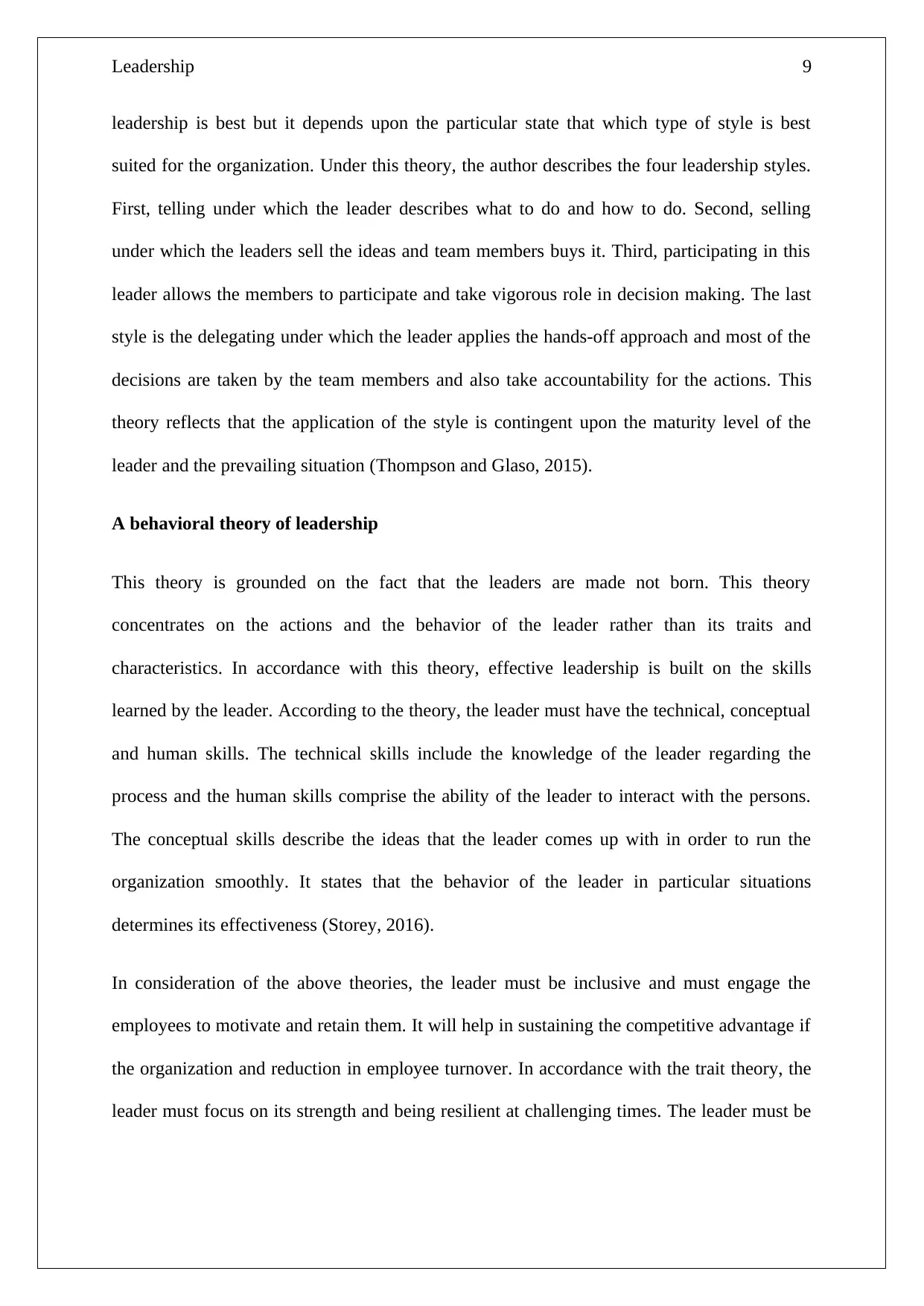
Leadership 9
leadership is best but it depends upon the particular state that which type of style is best
suited for the organization. Under this theory, the author describes the four leadership styles.
First, telling under which the leader describes what to do and how to do. Second, selling
under which the leaders sell the ideas and team members buys it. Third, participating in this
leader allows the members to participate and take vigorous role in decision making. The last
style is the delegating under which the leader applies the hands-off approach and most of the
decisions are taken by the team members and also take accountability for the actions. This
theory reflects that the application of the style is contingent upon the maturity level of the
leader and the prevailing situation (Thompson and Glaso, 2015).
A behavioral theory of leadership
This theory is grounded on the fact that the leaders are made not born. This theory
concentrates on the actions and the behavior of the leader rather than its traits and
characteristics. In accordance with this theory, effective leadership is built on the skills
learned by the leader. According to the theory, the leader must have the technical, conceptual
and human skills. The technical skills include the knowledge of the leader regarding the
process and the human skills comprise the ability of the leader to interact with the persons.
The conceptual skills describe the ideas that the leader comes up with in order to run the
organization smoothly. It states that the behavior of the leader in particular situations
determines its effectiveness (Storey, 2016).
In consideration of the above theories, the leader must be inclusive and must engage the
employees to motivate and retain them. It will help in sustaining the competitive advantage if
the organization and reduction in employee turnover. In accordance with the trait theory, the
leader must focus on its strength and being resilient at challenging times. The leader must be
leadership is best but it depends upon the particular state that which type of style is best
suited for the organization. Under this theory, the author describes the four leadership styles.
First, telling under which the leader describes what to do and how to do. Second, selling
under which the leaders sell the ideas and team members buys it. Third, participating in this
leader allows the members to participate and take vigorous role in decision making. The last
style is the delegating under which the leader applies the hands-off approach and most of the
decisions are taken by the team members and also take accountability for the actions. This
theory reflects that the application of the style is contingent upon the maturity level of the
leader and the prevailing situation (Thompson and Glaso, 2015).
A behavioral theory of leadership
This theory is grounded on the fact that the leaders are made not born. This theory
concentrates on the actions and the behavior of the leader rather than its traits and
characteristics. In accordance with this theory, effective leadership is built on the skills
learned by the leader. According to the theory, the leader must have the technical, conceptual
and human skills. The technical skills include the knowledge of the leader regarding the
process and the human skills comprise the ability of the leader to interact with the persons.
The conceptual skills describe the ideas that the leader comes up with in order to run the
organization smoothly. It states that the behavior of the leader in particular situations
determines its effectiveness (Storey, 2016).
In consideration of the above theories, the leader must be inclusive and must engage the
employees to motivate and retain them. It will help in sustaining the competitive advantage if
the organization and reduction in employee turnover. In accordance with the trait theory, the
leader must focus on its strength and being resilient at challenging times. The leader must be
Paraphrase This Document
Need a fresh take? Get an instant paraphrase of this document with our AI Paraphraser
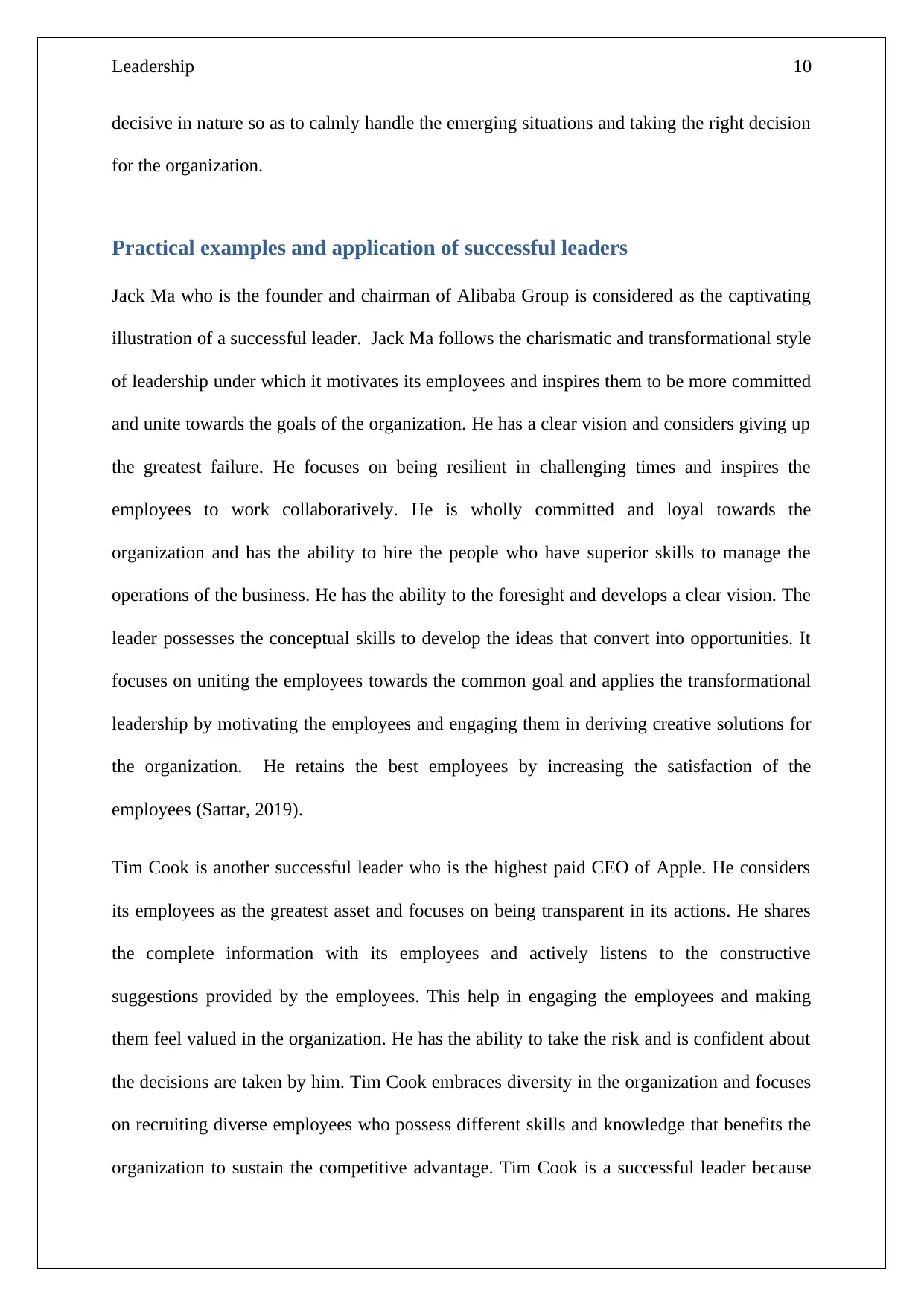
Leadership 10
decisive in nature so as to calmly handle the emerging situations and taking the right decision
for the organization.
Practical examples and application of successful leaders
Jack Ma who is the founder and chairman of Alibaba Group is considered as the captivating
illustration of a successful leader. Jack Ma follows the charismatic and transformational style
of leadership under which it motivates its employees and inspires them to be more committed
and unite towards the goals of the organization. He has a clear vision and considers giving up
the greatest failure. He focuses on being resilient in challenging times and inspires the
employees to work collaboratively. He is wholly committed and loyal towards the
organization and has the ability to hire the people who have superior skills to manage the
operations of the business. He has the ability to the foresight and develops a clear vision. The
leader possesses the conceptual skills to develop the ideas that convert into opportunities. It
focuses on uniting the employees towards the common goal and applies the transformational
leadership by motivating the employees and engaging them in deriving creative solutions for
the organization. He retains the best employees by increasing the satisfaction of the
employees (Sattar, 2019).
Tim Cook is another successful leader who is the highest paid CEO of Apple. He considers
its employees as the greatest asset and focuses on being transparent in its actions. He shares
the complete information with its employees and actively listens to the constructive
suggestions provided by the employees. This help in engaging the employees and making
them feel valued in the organization. He has the ability to take the risk and is confident about
the decisions are taken by him. Tim Cook embraces diversity in the organization and focuses
on recruiting diverse employees who possess different skills and knowledge that benefits the
organization to sustain the competitive advantage. Tim Cook is a successful leader because
decisive in nature so as to calmly handle the emerging situations and taking the right decision
for the organization.
Practical examples and application of successful leaders
Jack Ma who is the founder and chairman of Alibaba Group is considered as the captivating
illustration of a successful leader. Jack Ma follows the charismatic and transformational style
of leadership under which it motivates its employees and inspires them to be more committed
and unite towards the goals of the organization. He has a clear vision and considers giving up
the greatest failure. He focuses on being resilient in challenging times and inspires the
employees to work collaboratively. He is wholly committed and loyal towards the
organization and has the ability to hire the people who have superior skills to manage the
operations of the business. He has the ability to the foresight and develops a clear vision. The
leader possesses the conceptual skills to develop the ideas that convert into opportunities. It
focuses on uniting the employees towards the common goal and applies the transformational
leadership by motivating the employees and engaging them in deriving creative solutions for
the organization. He retains the best employees by increasing the satisfaction of the
employees (Sattar, 2019).
Tim Cook is another successful leader who is the highest paid CEO of Apple. He considers
its employees as the greatest asset and focuses on being transparent in its actions. He shares
the complete information with its employees and actively listens to the constructive
suggestions provided by the employees. This help in engaging the employees and making
them feel valued in the organization. He has the ability to take the risk and is confident about
the decisions are taken by him. Tim Cook embraces diversity in the organization and focuses
on recruiting diverse employees who possess different skills and knowledge that benefits the
organization to sustain the competitive advantage. Tim Cook is a successful leader because
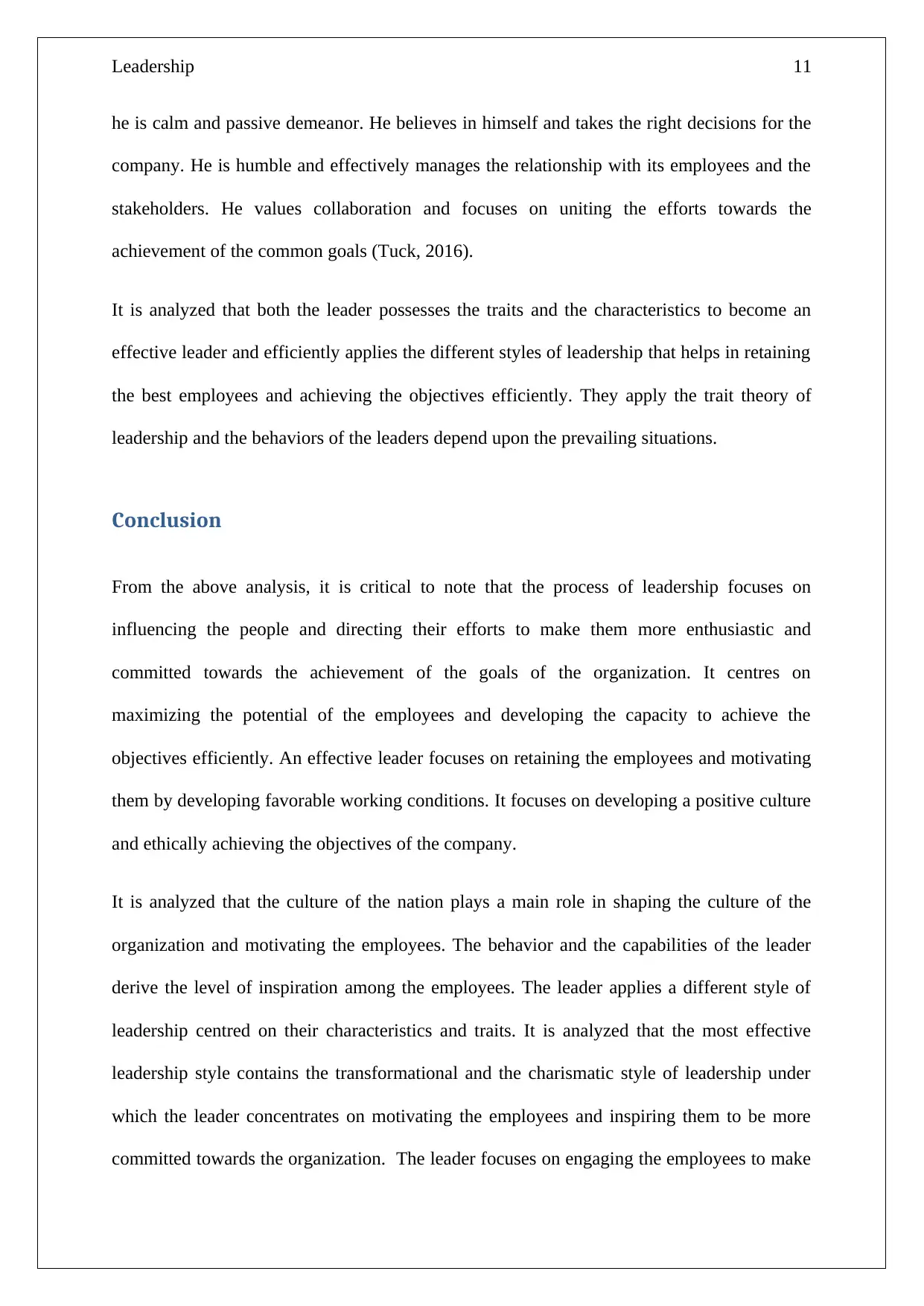
Leadership 11
he is calm and passive demeanor. He believes in himself and takes the right decisions for the
company. He is humble and effectively manages the relationship with its employees and the
stakeholders. He values collaboration and focuses on uniting the efforts towards the
achievement of the common goals (Tuck, 2016).
It is analyzed that both the leader possesses the traits and the characteristics to become an
effective leader and efficiently applies the different styles of leadership that helps in retaining
the best employees and achieving the objectives efficiently. They apply the trait theory of
leadership and the behaviors of the leaders depend upon the prevailing situations.
Conclusion
From the above analysis, it is critical to note that the process of leadership focuses on
influencing the people and directing their efforts to make them more enthusiastic and
committed towards the achievement of the goals of the organization. It centres on
maximizing the potential of the employees and developing the capacity to achieve the
objectives efficiently. An effective leader focuses on retaining the employees and motivating
them by developing favorable working conditions. It focuses on developing a positive culture
and ethically achieving the objectives of the company.
It is analyzed that the culture of the nation plays a main role in shaping the culture of the
organization and motivating the employees. The behavior and the capabilities of the leader
derive the level of inspiration among the employees. The leader applies a different style of
leadership centred on their characteristics and traits. It is analyzed that the most effective
leadership style contains the transformational and the charismatic style of leadership under
which the leader concentrates on motivating the employees and inspiring them to be more
committed towards the organization. The leader focuses on engaging the employees to make
he is calm and passive demeanor. He believes in himself and takes the right decisions for the
company. He is humble and effectively manages the relationship with its employees and the
stakeholders. He values collaboration and focuses on uniting the efforts towards the
achievement of the common goals (Tuck, 2016).
It is analyzed that both the leader possesses the traits and the characteristics to become an
effective leader and efficiently applies the different styles of leadership that helps in retaining
the best employees and achieving the objectives efficiently. They apply the trait theory of
leadership and the behaviors of the leaders depend upon the prevailing situations.
Conclusion
From the above analysis, it is critical to note that the process of leadership focuses on
influencing the people and directing their efforts to make them more enthusiastic and
committed towards the achievement of the goals of the organization. It centres on
maximizing the potential of the employees and developing the capacity to achieve the
objectives efficiently. An effective leader focuses on retaining the employees and motivating
them by developing favorable working conditions. It focuses on developing a positive culture
and ethically achieving the objectives of the company.
It is analyzed that the culture of the nation plays a main role in shaping the culture of the
organization and motivating the employees. The behavior and the capabilities of the leader
derive the level of inspiration among the employees. The leader applies a different style of
leadership centred on their characteristics and traits. It is analyzed that the most effective
leadership style contains the transformational and the charismatic style of leadership under
which the leader concentrates on motivating the employees and inspiring them to be more
committed towards the organization. The leader focuses on engaging the employees to make
⊘ This is a preview!⊘
Do you want full access?
Subscribe today to unlock all pages.

Trusted by 1+ million students worldwide
1 out of 16
Related Documents
Your All-in-One AI-Powered Toolkit for Academic Success.
+13062052269
info@desklib.com
Available 24*7 on WhatsApp / Email
![[object Object]](/_next/static/media/star-bottom.7253800d.svg)
Unlock your academic potential
Copyright © 2020–2025 A2Z Services. All Rights Reserved. Developed and managed by ZUCOL.





